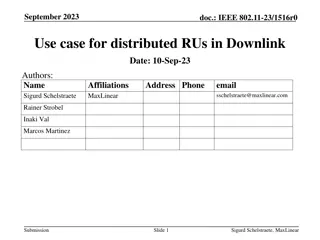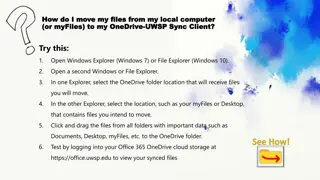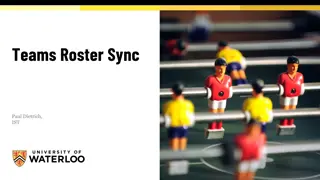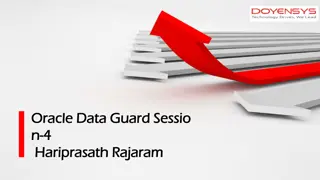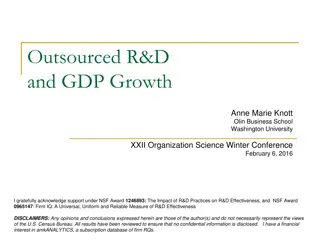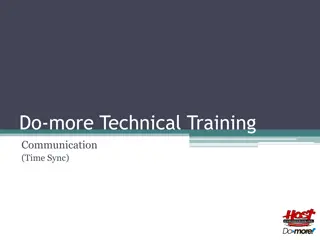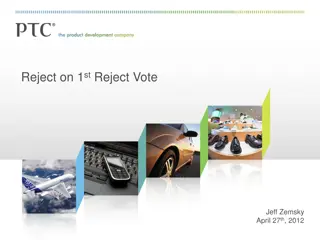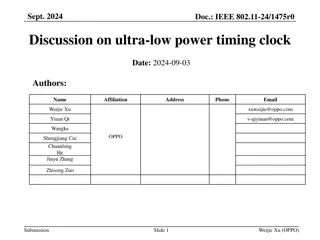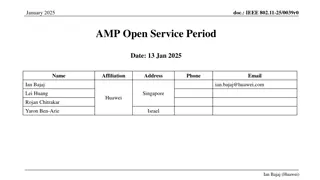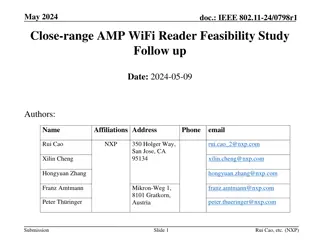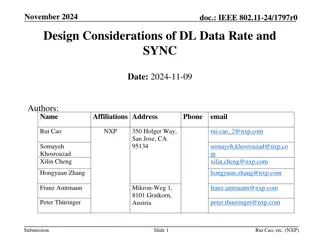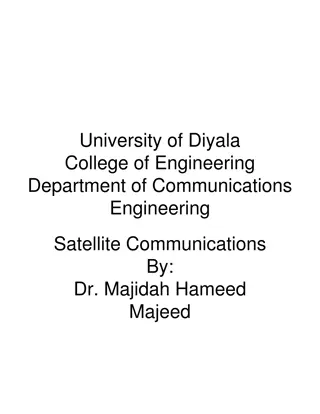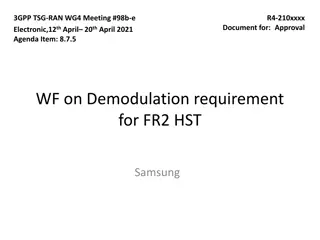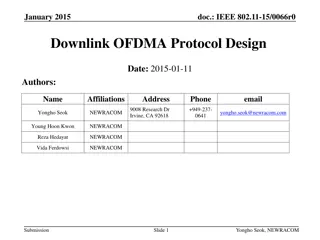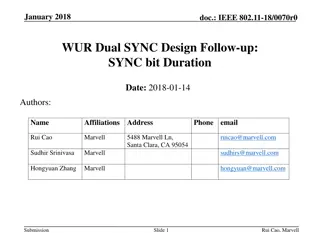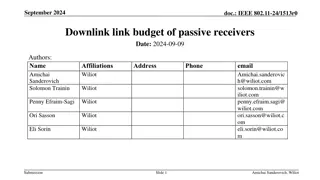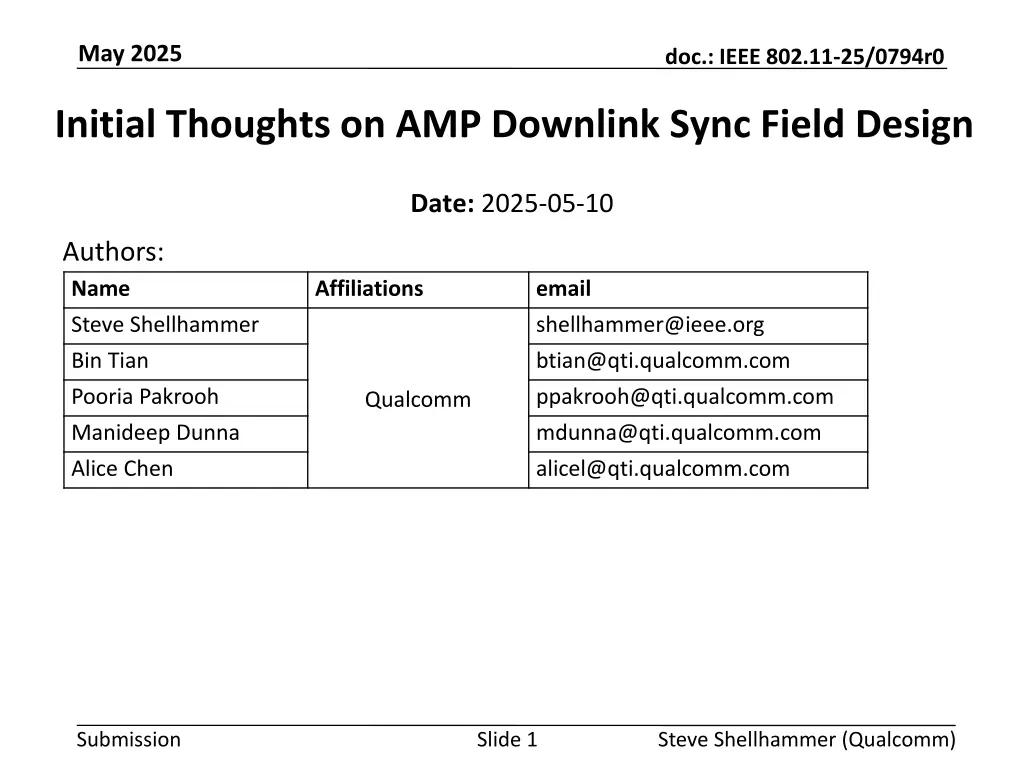
Initial Thoughts on IEEE 802.11-25/0794r0 AMP Downlink Sync Field Design
Explore high-level thoughts on designing the AMP Downlink Sync field for non-Backscatter STAs in IEEE 802.11-25/0794r0. Discover requirements, proposed design concepts, simulation results, and more for this important field in wireless communication.
Download Presentation

Please find below an Image/Link to download the presentation.
The content on the website is provided AS IS for your information and personal use only. It may not be sold, licensed, or shared on other websites without obtaining consent from the author. If you encounter any issues during the download, it is possible that the publisher has removed the file from their server.
You are allowed to download the files provided on this website for personal or commercial use, subject to the condition that they are used lawfully. All files are the property of their respective owners.
The content on the website is provided AS IS for your information and personal use only. It may not be sold, licensed, or shared on other websites without obtaining consent from the author.
E N D
Presentation Transcript
May 2025 doc.: IEEE 802.11-25/0794r0 Initial Thoughts on AMP Downlink Sync Field Design Date: 2025-05-10 Authors: Name Affiliations email Steve Shellhammer shellhammer@ieee.org Bin Tian Pooria Pakrooh btian@qti.qualcomm.com ppakrooh@qti.qualcomm.com Qualcomm Manideep Dunna mdunna@qti.qualcomm.com Alice Chen alicel@qti.qualcomm.com Submission Slide 1 Steve Shellhammer (Qualcomm)
May 2025 doc.: IEEE 802.11-25/0794r0 Introduction Here we introduce some high-level thoughts on the design for the AMP Downlink Sync field for transmission to non- Backscatter STAs We provide our thoughts on the requirements Description of our Proposed Design Concept We give Data field simulation results to understand the SNR requirements for the Sync field detection We provide some Sync field detection simulation results Submission Slide 2 Steve Shellhammer (Qualcomm)
May 2025 doc.: IEEE 802.11-25/0794r0 Requirement for Downlink PPDU Sync Field The non-Backscatter receivers need to decode both the 1 Mb/s and the 250 kb/s PPDUs It is beneficial if the Sync field can indicate the downlink data rate The Sync field should be more robust than the Data field The Sync field should support both a higher power/performance Sync detector and lower power/performance Sync field detector The Sync field should provide timing alignment for the Data field decoding The Sync field detector should work with clock error of TBD PPM o Task Group has not yet specified the receiver clock error for non- Backscatter STAs o Some people have suggested ??,??? PPM Submission Slide 3 Steve Shellhammer (Qualcomm)
May 2025 doc.: IEEE 802.11-25/0794r0 Downlink Sync Field High-Level Thoughts We propose to use a chip duration of 2 s, which will be more robust to multipath channels than 0.5 s chip duration We propose to use a sequence ? for the 250 kb/s PPDU We propose to use a sequence ? for the 1 Mb/s PPDU o ? indicates the logical complement of ? ? is selected to meet the following requirements: o Has good autocorrelation properties o We need to have a discussion on if we use Manchester encoding in the Sync Field The Test Statistic for the W Sync field detector can easily be converted to the Test Statistic for the ? Sync field detector by a simple change of the sign Hence the complexity is reduced essentially to a single Sync field detector Submission Slide 4 Steve Shellhammer (Qualcomm)
May 2025 doc.: IEEE 802.11-25/0794r0 Simulation Parameters Parameter Transmit Bandwidth Transmit Waveform Value < 20 MHz Either OFDM or Simple OOK is fine Comment Fit within 20 MHz Channel Receiver Bandwidth SNR Definition 80 MHz RX Signal Power (in dB) minus Noise Power over 80 MHz (in dB). Using the 80 MHz receive waveform. TBD PPM No RF Filter If zero padding is done before and after the signal, that portion is not included in the RX Signal Power SFD specifies Active TX Uplink Clock Accuracy of ???? PPM but does specify the RX Clock Accuracy. Some people have indicated interest in supporting ??,??? PPM for RX. Details of Envelop Detector model need to be clarified Tag has poor clock accuracy and needs to wake-up early and listen for Sync Field Size in Octets for Data Field. Downlink is expected to be smaller than uplink Receiver Clock Accuracy Receiver Architecture Envelope Detector (Non-Coherent) 5 ms Sync Detection False Alarm Rate Definition Interval Data Field Size 10 Octets Submission Slide 5 Steve Shellhammer (Qualcomm)
May 2025 doc.: IEEE 802.11-25/0794r0 Data Field Simulation (For Reference) At a 10% PER the 250 kb/s Downlink has an SNR of around 6.9 dB The SNR for the 1 Mb/s Downlink has an SNR of around 3.3 dB We want the Sync field Detector to work a few dB lower than 6.9 dB Submission Slide 6 Steve Shellhammer (Qualcomm)
May 2025 doc.: IEEE 802.11-25/0794r0 Correlation-based Sync Field Detector Sampler runs at 8 MHz Reference Array is ? = The Test Statistic is X/Y o Y normalizes for different receive power levels o Division is easily converted to a multiplication in an implementation ?? ? , sampled at 8 MHz Submission Slide 7 Steve Shellhammer (Qualcomm)
May 2025 doc.: IEEE 802.11-25/0794r0 Example Sync Field Length Simulations Simulated several length Sync Fields o Lengths Simulated: 16, 24, and 32 Chips o Chip Duration = 2 s Set Detector Threshold to meet a False Alarm Rate of ?? ? with 5 ms of Noise Input Plotted Sync Detection Failure Rate Tabulated SNR for 10% Sync Detection Failure Rate Calculated Margin compared to 250 kb/s Data Field Submission Slide 8 Steve Shellhammer (Qualcomm)
May 2025 doc.: IEEE 802.11-25/0794r0 Noise Only Simulation Example Sync Sequence Length = 32 Chips 5 ms of AWGN Plot the CCDF of the Test Statistic Set the False Alarm rate at 10 ? Select Test Statistic value to meet the target False Alarm Rate Selected Threshold Value show in Red Dot Submission Slide 9 Steve Shellhammer (Qualcomm)
May 2025 doc.: IEEE 802.11-25/0794r0 Sync Field Detector Failure Rate versus SNR Three Sync Lengths o 16, 24, and 32 Chips o Chip Duration = 2 s Submission Slide 10 Steve Shellhammer (Qualcomm)
May 2025 doc.: IEEE 802.11-25/0794r0 Sync Field Detection Required SNR Sync Field Length (Chips) Required SNR for 10% Sync Detection Failure Rate (dB) 250 kb/s Data Field Required SNR for 10% BER (dB) Margin (dB) 7.8 6.9 0.9 16 8.8 6.9 1.9 24 9.6 6.9 2.7 32 Submission Slide 11 Steve Shellhammer (Qualcomm)
May 2025 doc.: IEEE 802.11-25/0794r0 Summary Proposed using 2 s chip duration for Downlink Sync field transmitted to non-Backscatter STAs Proposed using Sync Field sequence ? for 250 kb/s PPDUs and ? for 1 Mb/s PPDUs o Enables simple Sync field detector which can use a positive Sync field threshold for 250 kb/s PPDU and a negative threshold for 1 Mb/s PPDU ? is selected to have good autocorrelation properties Provided simulation results for the Correlation-based Detector o Simulated three Sync Field Lengths: 16, 24, and 32 Chips Submission Slide 12 Steve Shellhammer (Qualcomm)

